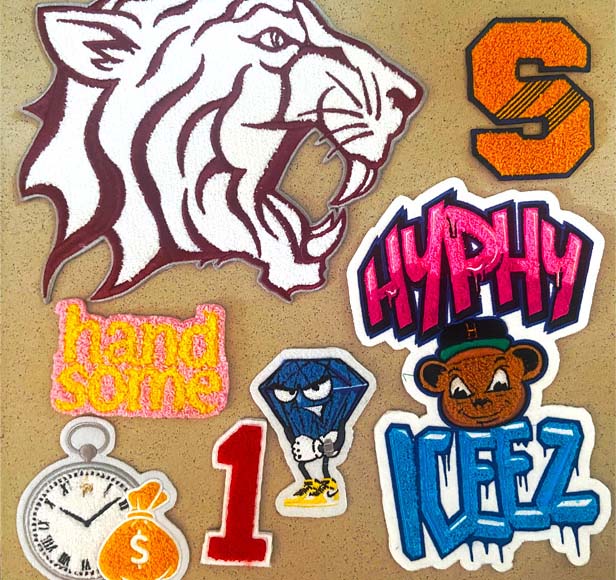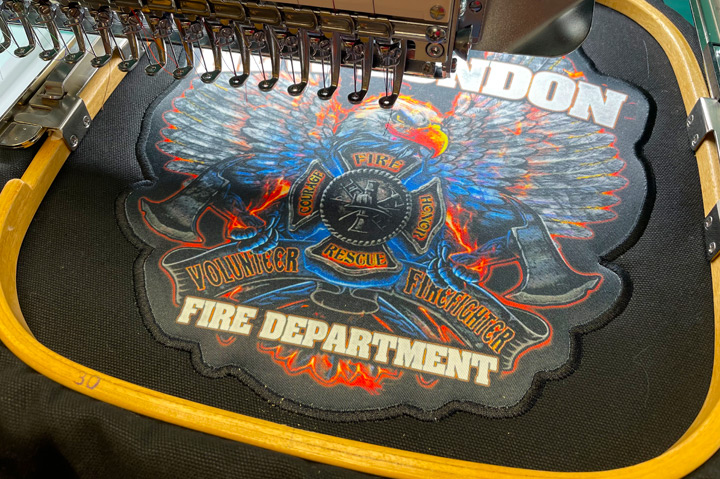Product Hub December 14, 2021
Try These 3 Appliqué Trends
Layering one or more pieces of fabric onto various garments can create stylish designs and sometimes save time and money over other decorating techniques.
For so many of the biggest trends in apparel right now, appliqué decoration is front and center – whether it’s a letterman’s jacket adorned with fuzzy, chenille patches, a chunky, heavyweight sweatshirt emblazoned with an alma mater in bold tackle twill lettering or a dad hat with a meaningful message affixed to the front.
Appliqué, where one or more layers of fabric – or other materials – are stitched or heat-pressed onto a garment, can add dimension and visual interest to a decoration. It can also save time or money on designs that would be too complex rendered in embroidery, especially for decorators who’ve invested in laser-cutting technology. A full embroidered piece could take two hours at full scale to complete, whereas “the average twill or laser piece takes 20 to 30 minutes and looks so much better and has a higher resale value depending on your skill level,” says Howard Potter, CEO of A&P Master Images (asi/102019) in Utica, NY.
Consider these trending appliqué ideas for your next promo apparel project.
1. Chenille Patches

Fuzzy chenille patches, like these from Quality Patches, get their name from the French word for caterpillar.
The demand for chenille patches has been so high, says Karen Ria, co-owner of Quality Punch and Quality Patches, that her company has had to struggle to keep up. “We just can’t make enough,” she says. The appeal is in the feel: “The pop-out look and soft, fuzzy touch make it a very unique form of decoration. No one can pass by a chenille item and not touch it, I’m willing to bet on that.”
A chenille patch is the perfect accompaniment to a varsity or denim jacket. It can also top off a cap.
Be sure to source chenille patches from a reliable vendor, Ria advises. Though the process of attaching chenille to a garment isn’t too difficult – either by machine appliqué or heat press – creating the patch itself is a bit more complex. “Chenille digitizing is tricky by itself,” Ria says. “In production, many things come into play: thickness, consistency and durability.”
Sublimated Appliqué

Dye-sublimated tackle twill, like this design from A&P Master Images, can be a time-saving way to produce complicated artwork over traditional embroidery.
Potter started offering dye-sublimated tackle twill decoration as well as sublimated reverse laser appliqué more than a decade ago. “Both bring a unique approach to give your customers a full-color design, which allows you to produce the products faster,” he adds.
Sublimated tackle twill opens up a lot of design options. Decorators could dye sublimate artwork that would have been embroidered, then attach the sublimated twill to save time and reduce costs. But they can also get more abstract: Consider a sweatshirt for a zoo gift shop where the letters are appliqué twill, sublimated with various animal print designs.
Specialty Materials
View this post on Instagram
Going beyond traditional twill can add a fashion flair to appliqué designs. Experiment with dimensional finishes, glitter vinyl, metallics and other materials to create unique looks. Felt gives designs a vintage feel.
Top 40 supplier Vantage Apparel (asi/93390) offers what it calls “tech appliqué” in its decoration arsenal. The award-winning supplier-decorator uses a foam-like tech fabric to outline lettering and simple logo designs, or as a base layer to twill fabric to add dimension to a design. Cotton-rib appliqué has a lighter, “worn-in” look, making it a great choice for T-shirts and garment-washed apparel. It’s also a great choice for reverse appliqué – where the appliqué is attached to the underside of a garment, and a design is laser-cut into the top layer, revealing the contrasting fabric beneath.

Product Hub
Find the latest in quality products, must-know trends and fresh ideas for upcoming end-buyer campaigns.
